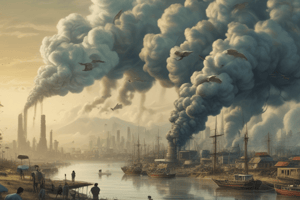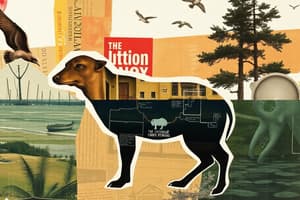Podcast
Questions and Answers
What is one of the primary functions of the Central Pollution Control Board (CPCB)?
What is one of the primary functions of the Central Pollution Control Board (CPCB)?
- Conduct on-site inspections of forests
- Regulate surface water levels
- Enforce criminal penalties on offenders
- Provide technical guidance to state boards (correct)
Which entity is responsible for taking samples from any water body for testing?
Which entity is responsible for taking samples from any water body for testing?
- Ministry of Environment
- Environmental Protection Agency
- Central Pollution Control Board
- State Pollution Control Board (correct)
What key provision was added to the Air (Prevention and Control of Pollution) Act in 1987?
What key provision was added to the Air (Prevention and Control of Pollution) Act in 1987?
- Carbon footprint regulations
- Noise pollution regulations (correct)
- Plastic waste management guidelines
- Water pollution penalties
What must new industries obtain from the State Pollution Control Board (SPCB) before starting operations?
What must new industries obtain from the State Pollution Control Board (SPCB) before starting operations?
Which of the following is NOT a role of the Central Pollution Control Board?
Which of the following is NOT a role of the Central Pollution Control Board?
What does the Environment Protection Act 1986 aim to control in regards to air pollution?
What does the Environment Protection Act 1986 aim to control in regards to air pollution?
What is defined as 'environmental pollution' under the Environment Protection Act?
What is defined as 'environmental pollution' under the Environment Protection Act?
Which of the following is a guideline advised to industries under the Environment Protection Act focused on effluents?
Which of the following is a guideline advised to industries under the Environment Protection Act focused on effluents?
What is one of the major drawbacks regarding the enforcement of environmental legislation mentioned?
What is one of the major drawbacks regarding the enforcement of environmental legislation mentioned?
How can public awareness about environmental issues be effectively propagated among students?
How can public awareness about environmental issues be effectively propagated among students?
What factor has contributed to public unawareness of environmental impacts according to the content?
What factor has contributed to public unawareness of environmental impacts according to the content?
Which of the following is NOT mentioned as a guideline for hazardous substance management?
Which of the following is NOT mentioned as a guideline for hazardous substance management?
What challenge do small industries face in terms of effluent treatment plants (ETPs)?
What challenge do small industries face in terms of effluent treatment plants (ETPs)?
What is the primary purpose of the Environmental Protection Act of 1986?
What is the primary purpose of the Environmental Protection Act of 1986?
Which legislation was enacted to specifically address water pollution?
Which legislation was enacted to specifically address water pollution?
What significant change occurred after the Wild Life Protection Act of 1972?
What significant change occurred after the Wild Life Protection Act of 1972?
What was the key outcome of the 1972 UN Conference on the Human Environment?
What was the key outcome of the 1972 UN Conference on the Human Environment?
Which Indian constitutional amendment emphasizes the duty of citizens to protect the environment?
Which Indian constitutional amendment emphasizes the duty of citizens to protect the environment?
What is the significance of Article 48A in the Indian Constitution?
What is the significance of Article 48A in the Indian Constitution?
Which act specifies the appointment of authorities such as wildlife wardens?
Which act specifies the appointment of authorities such as wildlife wardens?
Which of the following acts could be associated with air pollution control?
Which of the following acts could be associated with air pollution control?
What was one of the goals of the Forest Conservation Act of 1980?
What was one of the goals of the Forest Conservation Act of 1980?
Which legislation is focused on controlling pollution in bodies of water?
Which legislation is focused on controlling pollution in bodies of water?
Flashcards
Environmental Pollution
Environmental Pollution
Presence of harmful gases, solids, or liquids that are detrimental to the environment.
Hazardous Substance
Hazardous Substance
Any substance with potential to harm living beings and the environment.
Environmental Protection Act (1986)
Environmental Protection Act (1986)
Indian law aiming to protect the environment, including air, water, and land.
Air pollution control area
Air pollution control area
Signup and view all the flashcards
Pollution standards
Pollution standards
Signup and view all the flashcards
Public Awareness
Public Awareness
Signup and view all the flashcards
Enforcement Drawbacks
Enforcement Drawbacks
Signup and view all the flashcards
Cleaner Technologies
Cleaner Technologies
Signup and view all the flashcards
CPCB's Role
CPCB's Role
Signup and view all the flashcards
SPCB's Role
SPCB's Role
Signup and view all the flashcards
What are ETPs?
What are ETPs?
Signup and view all the flashcards
Air Pollution Definition
Air Pollution Definition
Signup and view all the flashcards
Noise Pollution's Addition
Noise Pollution's Addition
Signup and view all the flashcards
Consumerism
Consumerism
Signup and view all the flashcards
Problem of improper consumerism
Problem of improper consumerism
Signup and view all the flashcards
Two types of over-population
Two types of over-population
Signup and view all the flashcards
Per capita consumption
Per capita consumption
Signup and view all the flashcards
Impact of consumerism on environment
Impact of consumerism on environment
Signup and view all the flashcards
Environmental legislation
Environmental legislation
Signup and view all the flashcards
UN Conference on Human Environment (1972)
UN Conference on Human Environment (1972)
Signup and view all the flashcards
Article 48A and 51A(g) of Indian Constitution
Article 48A and 51A(g) of Indian Constitution
Signup and view all the flashcards
Wild Life Protection Act (1972)
Wild Life Protection Act (1972)
Signup and view all the flashcards
Indian Board of Wild Life (IBWL)
Indian Board of Wild Life (IBWL)
Signup and view all the flashcards
Study Notes
Module 6: Social Issues and the Environment
- Urban problems relate to energy and sustainable development
- Water conservation, rain water harvesting, watershed management, rehabilitation problems (case studies) are covered
- Wasteland reclamation, consumerism, and waste products are discussed
- Environment Protection Act, Air, Water, Wildlife, and Forest Conservation Acts are mentioned
- Environmental legislation and public awareness are key topics
Sustainable Development
- The drive for improved quality of life led to environmental issues
- Development is not just about economic growth; other factors matter for quality of life
- Economic development has led to overexploitation of natural resources, biodiversity loss, a lack of environmental awareness, and increasing economic differences within and between nations
- Overfishing is highlighted as a concern for seafood scarcity in 2050
Sustainable Development Definition
- "Development that meets the needs of the present without compromising the ability of future generations to meet their own needs." (Brundtland, G.H.)
- Sustainable development aims to balance social, environmental, and economic factors
Sustainable Development - Key Aspects
- Inter-generational Equity: Protecting the environment for future generations
- Intra-generational Equity: Reducing economic inequality between rich and poor countries
Measures to Achieve Sustainable Development
- Use locally adaptable, eco-friendly, and culturally appropriate technologies
- Minimize resource use, reuse resources and recycle
- Promote environmental education, public awareness, and training
- Limit resource utilization to carrying capacity
Carrying Capacity
- The maximum number of individuals a given area can support without degrading the natural, social, cultural, and economic environment
- Exceeding carrying capacity negatively impacts sustainable development
- Carrying capacity has supporting (regenerative) and assimilative (tolerance) components
Sustainable Development in Indian Context
- India's economy grew in the last 50 years, but the rich-poor gap also widened
- India achieves food self-sufficiency but with increased fertilizer and pesticide use
- Rapid population growth (17 million yearly) is a challenge
- Increased industry leads to pollution of land, water, and air
- Rural-to-urban migration creates strain on urban resources
What Can Be Done?
- Personal: Consumption patterns, water and energy use, clothing, recreation, yard care, household products, home purchase, vacation planning, family planning, transportation choices
- Business: Production methods, energy and water use, waste disposal, employee benefits, stockholder relations
- Community: Building a sustainable development center/organization, running summer schools, conference planning, devotional programs
Urbanization
- Urbanization is the increase in population in cities due to rural-urban migration
- Reasons include: job searching, better education, more commodities, and accessible health facilities
- Urbanization impacts the environment with increased population density, traffic jams, resource strain, greater pollution, decreased aesthetic quality, loss of farmland, biodiversity reduction, increased risk of flooding and ecosystem fragmentation
Urban Energy Problems
- Urban areas have higher energy consumption than rural areas
- More than 50% of the world's population lives in urban areas
- Urban development consumes more energy and produces more waste
Energy Demands in Urban Areas
- Lightings, transportation, modern electric gadgets, industries, waste disposal, and pollution prevention all require energy
Energy Conservation
- Search for renewable resources (Tidal, wind, biomass, solar, geothermal, hydrogen cells)
- Switch off lights/fans, use public transport, use energy-efficient devices, and other measures
Water Conservation and Watershed Management
- Water conservation practices are crucial
- Methods include decreasing run-off losses (contour cultivation, conservation bench terracing, water spreading, chemical conditioners, and water storage structures), reducing evaporation losses (asphalt sheets, super slurpers, planting trees), storing water in soil, reducing irrigation losses, reusing water, and stopping wastage (by closing taps, repairing leaks, using low-flush toilets)
- Increasing block pricing, introducing proper laws, and educating the public to conserve water are important
Rainwater Harvesting
- Rainwater harvesting is capturing and storing rainwater to recharge groundwater
- This involves constructing special water harvesting structures (dug wells, percolation pits, lagoons, check dams)
- Objectives include reducing run-off, avoiding flooding, meeting water demands, raising water tables, reducing contamination, and supplementing groundwater supplies during lean seasons
- Various methods, including storing in tanks, constructing pits/wells/lagoons, and recharging groundwater, are used
- Traditional methods, such as lakes, ponds, underground tanks in Rajasthan, and bamboo pipes in the Himalayas, are also highlighted
Watershed
- A watershed is a delineated area with a well-defined topographic boundary
- The land area from which water drains to a drainage channel (stream, river)
- Also called a catchment area, drainage basin, or river basin
- Watersheds have one well-defined boundary and water outlet
Watershed Degradation
- Improper land management causes watershed degradation, including overgrazing, mining, deforestation, construction activities, industrialization, shifting cultivation, fires, soil erosion, and local people's ignorance of land conservation
Watershed Management
- Rational utilization of land and water resources for optimum production with minimal environmental damage
- Objectives include restoring watersheds, providing water, irrigation, and hydropower, minimizing risks, and developing rural areas
Watershed Management Practices
- Water harvesting, afforestation/agroforestry, terracing, no-till farming, contour cropping, strip cropping, scientific mining, and public participation are key practices
Resettlement and Rehabilitation Issues
- Resettlement involves relocating people, typically due to infrastructure projects (dams, mines, national parks)
- Rehabilitation aims to restore displaced people to a usable position in society, focusing on their cultural and economic well-being
- Displacement often leads to major societal and livelihood disruptions for displaced tribes and villagers
Need for Resettlement and Rehabilitation
- Displacement occurs due to dam construction, mining, or national park creation
- Voluntary migration occurs due to job opportunities, fleeing epidemics, or wars
Displacement of People
- Development projects often displace people, especially native communities
- Many are affected by issues from the loss of their homes, work, and ancestral lands.
Wasteland Reclamation
- Wasteland reclamation involves bringing back unproductive land into productive use after environmental degradation
- Wasteland includes salt-affected, sandy, gullied, undulating upland, and snow-covered/glacial areas
- Key reasons for wasteland formation include natural factors (uplands, snow, and saline areas) and anthropogenic factors (deforestation, overgrazing, water logging, poor agricultural practices, industrial pollution, mining)
- Wasteland reclamation practices include land development and leaching, drainage, proper irrigation practices, crop selection, using gypsum, afforestation, and social forestry programs
Consumerism
- Consumerism is the theory that increased consumption of goods is economically beneficial
- It also involves a growing inclination towards the purchase of consumer goods
- Problems with improper consumerism include uncontrolled food manufacturing, food adulteration, poor service, and waste generation—which leads to natural resource depletion and environmental imbalance
- Population and lifestyle demands contribute significantly to exponential consumerism
Environmental Legislation
- Laws and acts protect the environment. Some key acts include
- Wild Life Protection Act (1972)
- Forest Conservation Act (1980)
- Water (Prevention and Control of Pollution) Act (1974)
- Air (Prevention and Control of Pollution) Act (1981)
- Environmental Protection Act (1986)
Public Awareness
- Education should equip people with environmental and pollution knowledge
- Policymakers need to promote environmental concerns and awareness
Studying That Suits You
Use AI to generate personalized quizzes and flashcards to suit your learning preferences.
Related Documents
Description
Test your knowledge on key aspects of environmental laws and pollution control measures in India. This quiz covers topics related to the Central Pollution Control Board, the Environment Protection Act, and the regulations surrounding pollution. Challenge yourself and learn more about environmental protection efforts!




